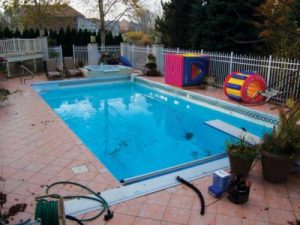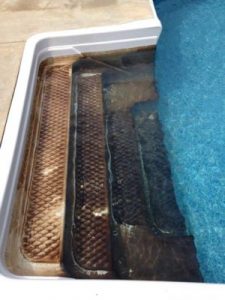When dealing with pool stains, it is important for service professionals to keep in mind they are not always cut from the same cloth. Therefore, it is critical to diagnose the problem first before providing a broad-spectrum treatment. Take the time to review the origins of common pool stains and determine what the likely cause is for each specific case before determining how it should be treated and removed. This article will provide a quick refresher for service professionals on some of the more common types of pool stains and what the best procedures are to remove them.
Copper stains (blue/green)
Copper discolorations are probably some of the most common stains found in pools. The introduction of copper to pool water can come from algaecides, heat exchangers, fill water, older copper plumbing, etc. The good news is most cases of blue/green staining can be prevented by following dosing charts on algaecides and maintaining a proper pH level in the water. However, as most service technicians can attest, this does not always happen.
There are liquids and dry granular treatments that work well to remove stains from all types of pool surfaces. The granular stain removers that are most commonly used in this scenario are citric acid and ascorbic acid. The granules do a good job of lifting the stain, but require the addition of a sequestering agent to help the filtration system trap the removed metals from the pool water.
Be aware some liquid stain removers also contain phosphoric and/or phosphonic acid, which will add phosphates to the pool water which will need to be removed at a later time. There are non-phosphate containing liquid sequesterants, but they are used to help remove metals that are already in the water. Non-phosphate sequesterants are only effective on new stains that have not yet set into the surface.
Do not mistake copper green for algae
Pool owners will often go into a pool store and simply say their water has turned green. To help the customer in this situation, a retail associate may immediately sell the consumer a copper algaecide to remove ‘algae;’ however, without further investigation, this will likely make the problem worse. When pool water turns green, it is extremely important to ask the customer the following question: “Is the water cloudy and green or is it clear and green?”
If the water is clear, but has a greenish cast then it is a sure sign of copper in the water. A good non-phosphate sequesterant will work to clear the copper (green) to the filter. If algae are the reason for the water turning green, the pool will also appear cloudy and the walls and floor will be slimy to the touch.
Purple haze

Copper cyanurate staining happens when there is a cyanuric acid (CYA) level greater than 100 parts per million (ppm) that combines with copper in the water.
Copper cyanurate staining happens when there is a cyanuric acid (CYA) level greater than 100 parts per million (ppm) that combines with copper in the water to form a purple precipitant along the pool surface, tile line, skimmers, and pool cleaner. This staining problem will continue to persist until the CYA level is reduced to approximately 50 ppm.
Once the CYA is lowered, the staining usually goes away as well; however, any affected areas may need to be brushed to remove some of the more stubborn stains. When the pool is drained to lower the CYA, it addresses the copper in the water as well. That said, a water test should still be performed to check for any remaining copper residual.
Iron stains
Iron stains will have a brown appearance, and if there is iron out of solution, the water will have a brownish tint. Iron can make its way into the pool in a number of ways. Some pool heater headers are comprised of iron and over time the protective layer can become worn down, exposing it to the pool’s chemistry. If the pool is equipped with an erosion tablet feeder that is plumbed in without the proper check valve in place it will erode the header as well.
Lawn care professionals can also inadvertently introduce iron into the pool via fertilizers. Well water, however, is the most common way iron gets introduced into the pool. In many areas of the country, people draw their water from wells which contain metals.
Iron stains in the pool can be removed using the same method described above for copper stains. In addition to removing the stains, be sure to balance the pool water and determine the source of the iron to minimize the chances of any further staining.
If the source is well water, there could be iron bacteria present; therefore, starting a routine maintenance program that consists of adding a sequestering agent on a weekly basis is highly recommended. It would be preferable to use a sequestering agent without phosphates to keep phosphate levels under control.
Organic stains

Tannins in leaves and other organic debris can leach out into the water and cause staining where it is resting.
As leaves and other organic materials make their way into the pool, and settle to the bottom, the tannins in the leaves can leach out into the water and cause staining where they were resting. This is pretty common as leaves sit on winter covers or at
the bottom of the pool during the off-season.
Oftentimes these stains will go away after the pool’s water chemistry is balanced and shocked to increase the chlorine level.
Galvanic corrosion
Galvanic corrosion is an electrochemical process in which one metal corrodes preferentially to another when both metals are in electrical contact in the presence of an electrolyte.
This occurs in pools equipped with salt generators every minute the cell is making chlorine. When galvanic corrosion happens, the corroded metals in the water can reach a saturation point and begin to stain the surface of the pool.
It does not corrode the salt cell because it is made of a more noble metal than pool ladders and light rings, etc. Adding a sacrificial anode made of zinc will help to slow down the occurrence of galvanic corrosion.
Zinc is a less noble metal than other metals associated with the pool, so it sacrifices itself to save the other metals from corroding. For this reason, it is a good idea to use a non-phosphate sequesterant as a maintenance tool in salt pools.
Conclusion

Iron stains will have a brown appearance, and if there is iron out of solution, the water will have a brownish tint.
When staining occurs, it is important to test the water first to make sure the water chemistry is balanced. If metals are present, a sequestering agent should be added to help remove them. This will also keep the metals from precipitating out of the water and creating more staining problems as the water chemistry is being corrected.
A lot of staining in pools can be attributed to the pH dropping and aggressively dissolving the metals into solution. Once the water is balanced, the real stain battle begins.
There will be occasions when every trick in the book has been attempted to remove different stains from the pool that will not lift off the surface. In these cases, the pool may need to be drained and acid washed to remove the staining. This generally is the case when dealing with plaster pools. Vinyl and fibreglass pools usually respond pretty well to the treatments discussed in this article since they are not as porous as plaster pools, thus allowing the stains to lift off easier.
An ounce of prevention is worth a pound of cure in the case of stain prevention. Pool professionals and their customers generally neglect brushing the pool walls and they also tend to avoid the steps needed to prevent staining. Simply adding a sequestering agent as part of a routine preventative maintenance program can go a long way in keeping pool surfaces looking newer much longer.
This article was written by Terry Arko and originally appeared on Pool & Spa Marketing [link].
